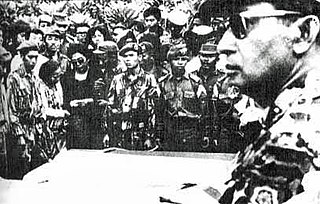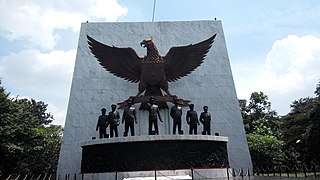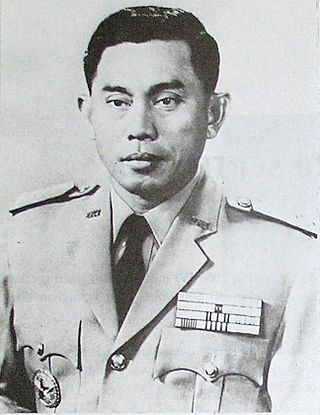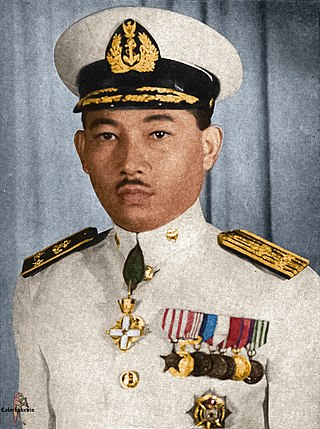
Abdul Haris Nasution was a high-ranking Indonesian general and politician. He served in the military during the Indonesian National Revolution and he remained in the military during the subsequent turmoil of the Parliamentary democracy and Guided Democracy. Following the fall of President Sukarno from power, he became the Speaker of the People's Consultative Assembly under President Suharto. Born into a Batak Muslim family, in the village of Hutapungkut, Dutch East Indies, he studied teaching and enrolled at a military academy in Bandung.
General of the army, was the highest rank of the Indonesian Army. It was the equivalent of admiral of the fleet and marshal of the air force within the Indonesian Armed Forces ranking system. These ranks were honorary and did not confer additional authority or responsibility.

Indonesia's transition to the New Order in the mid-1960s ousted the country's first president, Sukarno, after 22 years in the position. One of the most tumultuous periods in the country's modern history, it was also the commencement of Suharto's 31-year presidency.

The Thirtieth of September Movement was a self-proclaimed organization of Indonesian National Armed Forces members. In the early hours of 1 October 1965, they assassinated six Indonesian Army generals in an abortive coup d'état. Later that morning, the organization declared that it was in control of media and communication outlets and had taken President Sukarno under its protection. By the end of the day, the coup attempt had failed in Jakarta. Meanwhile, in central Java there was an attempt to take control over an army division and several cities. By the time this rebellion was put down, two more senior officers were dead.
Antara is an Indonesian news agency organized as a statutory corporation. It is the country's national news agency, supplying news reports to many domestic media organizations. It is the only organization authorized to distribute news materials created by foreign news agencies.

Guided Democracy, also called the Old Order, was the political system in place in Indonesia from 1959 until the New Order began in 1966. This period followed the dissolution of the liberal democracy period in Indonesia by President Sukarno, who centralized control in the name of political stability. He claimed to have based the system based on the traditional village system of discussion and consensus, which occurred under the guidance of village elders. On the national level, however, this meant centralized rule under Sukarno: martial law, a massive reduction in civil liberties and democratic norms, and the Indonesian National Armed Forces and Communist Party of Indonesia acting as major power blocs.

General Ahmad Yani was the Commander of the Indonesian Army, and was killed by members of the 30 September Movement during an attempt to kidnap him from his house.

The Jayakarta Jaya Military Regional Command ; abbreviated Kodam Jaya is the military district of the Indonesian Army which covers the Greater Jakarta area. Its role is to protect and defend the capital city area with other additional tasks, such as to support the local law enforcement and civil authorities.

The Third Working Cabinet was an Indonesian cabinet that resulted from a 6 March 1962 reshuffle of the previous cabinet by President Sukarno. It consisted of a first minister, two deputy first ministers, eight coordinating ministers, 36 ministers, as well as 13 members who headed various government bodies. It was dissolved on 13 November 1963.

The Dwikora Cabinet was the 23rd Indonesian cabinet. President Sukarno reshuffled the previous cabinet on 27 August 1964 to produce a cabinet better able to implement the government policy he had announced in his Independence Day speech entitled "The Year of Living Dangerously". The cabinet was appointed on 2 September and served for a year and five months before being reshuffled on 21 February 1966.

General Raden Oerip Soemohardjo was an Indonesian general, the first chief of general staff of the Indonesian National Armed Forces, and acting Commander of the Indonesian National Armed Forces. He received several awards from the Indonesian government, including the title National Hero of Indonesia in 1964.

Sudirman was an Indonesian military officer and revolutionary during the Indonesian National Revolution and the first commander of the Indonesian National Armed Forces.

The Satriamandala Museum is the main museum for the Indonesian Armed Forces. Opened on 5 October 1972, it is located on 5.6 hectares of land in South Jakarta and holds numerous artifacts, weapons, and vehicles.

Brigadier General Raden Panji Nugroho Notosusanto was an Indonesian short story writer turned military historian who served as a professor of history at the University of Indonesia. Born to a noble family in Central Java, he exhibited a high degree of nationalism from a young age. During the Indonesian National Revolution from 1945 to 1949, he saw active service as a member of the Student Army, working reconnaissance. Despite wanting to remain in the military, under the influence of his father he continued his education, eventually enrolling in the faculty of literature at the University of Indonesia. During the 1950s he wrote extensively and was active in numerous political and academic groups, finally graduating with a degree in history in 1958.

Admiral Raden Eddy Martadinata was an Indonesian Navy admiral and diplomat. He was given the title of National Hero of Indonesia posthumously in 1966. He is recognized as one of the founders of the Indonesian Navy.

Karel Sadsuitubun was an Indonesian police officer and national hero. Serving as a bodyguard for deputy prime minister Johannes Leimena, he was fatally wounded in the line of duty in a scuffle by communists during the 1965 coup d'état.

Dharma Wiratama Museum, officially the Dharma Wiratama Central Army Museum is a military museum centred on the history of the Indonesian Army from its inception in 1945 up through the coup of 30 September 1965 and Indonesian peacekeeping missions. It is located in the former national army headquarters in Yogyakarta.

Major General Pranoto Reksosamodra was an Indonesian Army general who was briefly army chief of staff and was detained for 15 years without trial for alleged involvement in the 30 September Movement coup attempt.
The following is an order of battle of the Indonesian National Armed Forces as of 8 January 1946, after the then People's Security Armed Forces was transformed into the People's Safety Armed Forces by Presidential Resolution #2/1946.

Wiluyo Puspoyudo was an Indonesian military figure and politician who became the deputy speaker of the People's Consultative Assembly from 1960 until 1966, and as the acting Speaker of the People's Consultative Assembly in 1966.


















